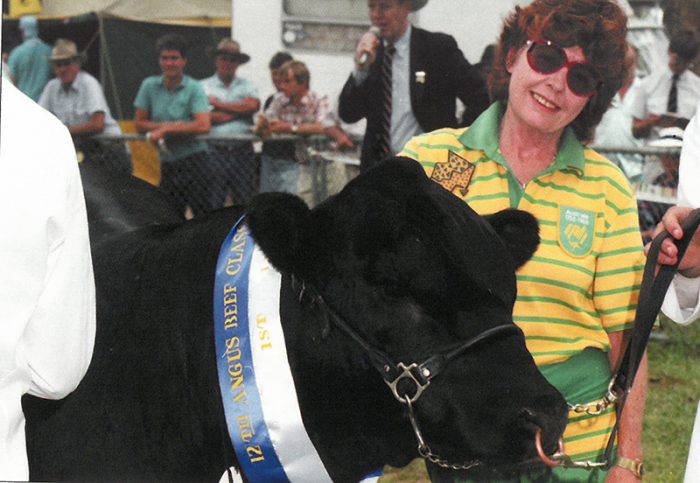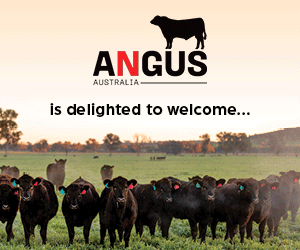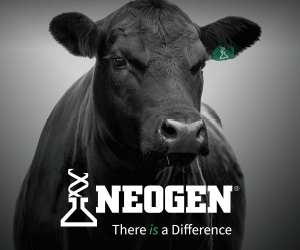1970 saw the Angus Society of Australia enter the second half of its century, with President AG Mackinnon at its helm.
With the beginnings of the Angus Herd Improvement Group and technologies forging forward, this quarter of the century really marked the push of the development of the marketing and breed development of the breed.
The presidents over the course of the 25 years were AG McKinnon (1969-1971), WHC Mayne (1971-1973), CG Cowley (1973-1975), JS Barnett (1976-1977), CH Lyons (1977-1979), C Stuart Gordon, (1979-1981), Rob Archer (1981-1983), Don Sundermann (1984-1985), David Raff (1985-1987), A (Joe) Grieve (1987-1989),C (Jim) Anderson (1989-1991), Lew Smit (1991-1994).
This period also saw the birth of the Angus Beef Classic, the Angus Youth Program, the National Junior Heifer and Herdsman Contests and the National Angus Youth Roundup.
During this quarter, the society office moved twice. In March 1972 the office was moved from Penfold Place, Sydney to the Sydney Showgrounds. In 1994 the office moved a second time, this time to Armidale, NSW where it still resides today.
The early 70s saw embryo transfer start to be utilised in Australia, with major advancements made in the late 70s to allow for non-surgical transfer of embryos as well as the simplification of freezing and thawing techniques as well as non-surgical transfer of these thawed embryos.
In 1974 in a trade mission sent to China and the Angus Society of Australia sent a bull and a heifer as part of Gough Whitlam’s normalisation of relations with China. Tom Gordon of Glendower Angus stud donated the heifer, Glendower Meg R4, and Don Moyle of The Basin Angus Stud donated the bull (name unknown).
Mr Gordon said the following about this mission, “Much preparation and ‘loving’ was lavished on Glendower Meg R4, to ensure that she was bullet proof, and fit for the journey. I believe that she was pregnant at the time of despatch.”
Much of the 1970s saw a time of economic strain for the society as a result of the 1974 beef industry collapse, resulting in a downturn of breeders registering their cattle due to the cost which severely affected the finances of the society. This required the presidents during this time, as well as the staff to make difficult decisions regarding the society’s decisions to ensure that it survived through this difficult period.
Leading from the front
Several figureheads within the staff during this time assisted the producers in developing the breed to what it is today.
Rupert Simpson was the secretary and general manager of Angus Australia for a number of years, until 1983. Mr Simpson was instrumental, along with the Angus Australia board at the time, in his work for the society during the aforementioned economic strain.
Mr Simpson assisted in the development of several initiatives by Angus Australia that assisted in continuing the success of the society during more difficult times, like the Angus Beef Classic.
Enid Fisher began her time at Angus Australia in 1972 as a registrar, when the society only had five on staff.
In 1983 Mrs Fisher became the Chief Executive Officer a role she held until 1994.
In this role Mrs Fisher developed a five-year corporate plan in 1986 that had the goal for the society achieving a greater share of the Australian beef market and being recognised as leaders in breed improvement. It was recognised as a bold plan, and one that assisted in the push for the industry leading adaption to breed development technologies.
Performance Recording takes a head:
The 1970s saw the emergence of the Angus Herd Improvement Group (AHIG) and its relevance to the Angus TACE as it is today. After its formation in 1966, the AMIG and all its assets were officially handed off to the society in 1970.
The same year the Angus Herd Improvement Scheme was formed by Chairperson James Litchfield of Hazeldean, Monaro, NSW, Gordon Munro of Booroomoka Angus, Bingara, NSW and Michael White of Belltrees, Scone, NSW.
It was at the 1970 beef industry conference held at the New England University, where a committee was appointed for a nationwide performance recording scheme. The committee had three sections, the first under Dr Arthur Rickards in the Agricultural Business Research Institute (ABRI), tasked to develop a data-recording system and compatible computer programming. Dr Keith Hammond headed the Animal Genetics and Breed Unit (AGBU) which reviewed the genetics underpinning the commercially significant traits that could be measured objectively in beef cattle and developed selection formulas. James Litchfield was the chairman of the technical subcommittee whose role was to examine the practical aspects of applying on farm technology.
The National Beef Recording Scheme (NBRS) was established in 1972 and in 1973 the Beef Improvement Association of Australia developed the Beef Sire Evaluation Programme, with the first test of this program being for the Angus breed.
A reference sire was selected and via artificial insemination was used to link between original herds used in performance recording. Eight herds took part in the test with the reference sire being V53 of PINEBANK, imported from New Zealand.
“The Trangie Project” was launched in 1974 by the NSW Agriculture and Fisheries, with the goal to provide information for improving the profitability of beef production through genetic selection. The project focused on the use if within-breed selection to improve economic returns on beef production.
This project investigated the growth and size, genetic trends, maternal performance and reproductive performance of the Trangie Angus Herd, which was split into three lines, comprised of a randomly selected line, a line selected for increased growth rate and a line selected for decreased growth rate. This format was selected to provide rapid divergence in growth rate between selection lines.
The findings produced through the research at Trangie was fundamental to the continued development of TACE, as over the course of the project it supplied a comprehensive recording program, supplying a large database for the evaluation of selection response and for the validation of the parameters of TACE.
In 1977, the society joined forces with the NBRS to develop the Angus Herd Improvement Register (AHIR).
At the time of the development of the AHIR in 1977, purebred Angus cattle made up 20% of the performance records in the NBRS database.
The register was established to cover the performance recording requirements of stud breeders and both the performance and pedigree requirements of commercial breeders. The immediate aim of the AHIR was “to improve the information available to a member for within in-herd selection.”
At this time, the process of integrated registering and performance recording was as follows:
- Stage 1: saw the member records the sire, dam and birth date of calf and its weight just prior to weaning. This was then mailed to NBRS in Armidale with the results of 3 reports to assist in selection decisions. The calves were ranked within sex groups on growth to weaning, there was a lifetime performance history for the dams and sires were ranked on the performance of their progeny.
- Stage 2: saw the progeny inspected by the Society’s classifier at yearly age to ensure the progeny were as they were being registered. Without the approval of the classifier, progeny would not be accepted to be registered.
- Stage 3: At 365 or 550 days, the weights of the progeny were recorded, and on completion were sent to NBRS for production of final weight test reports. These animals were ranked on the basis of their performance relative to contemporaries and the sires were than ranked on the final weight results of their progeny.
National Angus Group TACE was developed in the early 1980s as “an advanced genetic evaluation system that provides a genetic description of Angus cattle for a comprehensive range of traits.”
Angus TACE allowed for a database that assisted seedstock producers to identify within their Angus cattle the superior and inferior traits of particular animals, which allowed for data to be provided to commercial producers to assist for the selection of their breeding programs.
David Raff, former Angus Australia President and founder of Raff Angus was an early adopter of performance recording and was one of the first to enrol with the NBRS. In the book The Story of Angus in Australia written by Nigel Austin, Mr Raff said the following, “(Angus Group TACE) In turn provides data to the commercial bull buyers to help them select bulls with superior traits of economic importance to their breeding programs.”
In 1978, PertAngus, a group of avid early adopters of performance testing formed in 1970 were the first breeders to list the testicle size of bulls in a stud sale catalogue for the group’s annual bull sale. When speaking in the Febuary 2 1978 edition of the Countryman newspaper, PertAngus group member Fred Grimwade said the following, “Bull buyers want the most fertile and sexually active bull that matches their requirements. After all, the bull must be able to perform, or he is worthless. It is surprising that a simple measure like the size of testicles has not been universally available, particularly as it has the high heritability of 78 per cent.”
The Angus Sire Reference Scheme was introduced in 1979 with the assistance of NBRS and AGBU.
By the early 1980s, according to a breed percentage basis, Angus breeders were the highest users of the Group TACE. With this the idea was put forward of an across herd TACE analysis due to the active use of the same popular sires being used across many Angus herds.
Announced at the Angus Beef Classic in March 1986 in a first for the Australian beef industry, the Angus Sire Summary was developed with three major advantages for producers: They had a useful comparison on many sires allowing for greater selection pressure for important performance traits; it also allowed the advantage of helping to identify the sires in the breed with a combination of traits most useful to a specific producer’s herd and finally, it assisted in the credibility of seedstock producers to commercial producers by representing the genetic trends for the breed or a group of herds. In 1987 the first National Sire and Dam Summary was published.
The first National Ultrasonic Scan Carcase EBVs were published in 1990. Following this, Angus was the first British breed with gestation length EBVs in 1992. 1993 saw the Angus breed as the first in the world to publish across-breed fertility EBVs incorporating male and female traits.
By 1993, 70% of Angus bulls at members sales were presented with Angus TACE figures.
The farsightedness of Angus breeders to champion performance recording of commercial and seedstock cattle, and the interest and adoption, particularly in the 1970s has been credited to the progression of the breed into the modernised era of genomic technologies and the success of the breed in modern times. The development of the Angus TACE database to what it is today is a testament to the early innovators of the breed.
The Angus Beef Classic:
The first Angus Beef Classic (later known as the Angus National Show and Sale) was held in Wodonga in March 1977, sponsored by Suzuki.
The Angus Beef Classic was Australia’s first ever national show and sale and was a massive success, with over 800 Angus producers and spectators from around Australia coming together for the event.
The sale resulted in a bull sale average of $2,101, which was recorded at the time as the highest multi-vendor sale for the year. An Angus bull, Te Mania Tolerence was purchased at the sale by the Australian Government and was given as a gift to President Soeherto of Indonesia on behalf of Prime Minister Malcolm Fraser.
As a result of the success of the first Angus Beef Classic, more than 100 bulls were entered into the second annual Angus Classic in 1978.
The secretary of the Society at the time, Rupert Simpson, explained that overseas interest in the Angus breed had sharpened due to the Angus Classic the previous year. The overseas interest didn’t stop there, with American judge Dr Gary L. Minish and Scottish World Angus Authority Mr Roley Fraser also taking part as guests for the second event. During this event top selling Angus bull Te Mania Uranium sold for $21,000, breaking previous Angus records by more than double when sold to Mrs Laurie Kerr, Tibooburra stud.
The Angus National Show and Sale continued on for 26 years after its initial event in 1977.
Angus Youth is born:
The beginnings of the Angus Youth program started when the South Australian Angus Youth Committee was founded in 1977. This Youth Committee was developed due to the fact that the President of the Angus Society at the time, Colin Lyons, saw that the Society was struggling and that there was a potential for the longevity of the Society if the younger generations involved in the breed are supported and recognised.
It was at this time that the Reconstruction Committee was established, with David Cornell nominated as Chairman of this committee.
David Cornell had a vision for Angus Youth after travelling to the USA and visiting with Angus breeders. During this time, David discovered 1 in 3 members of the American Angus Society were Youth members, which held a stark difference to minimal numbers of Youth members in the Australian Angus Society.
The South Australian Committee General meeting (SA AGM) in September 1977 moved that 2 additional members were to be included in the committee that had to be aged under 25 years of age. The first members under 25 were F.W. (Bill) Cornell and John Pointon.
After these original discussions, three Youth projects where announced in South Australia in 1978. The first being a series of Angus cattle judging seminars, followed by increased support in the led steer class at Royal Adelaide Show. This saw heightened encouragement for schools to prepare steers donated by Angus breeders with the intention to encourage young people to be involved with the breed.
The National Junior Angus Heifer Show and Herdsman’s Contest was developed as part of a change in the Angus Society at the time to put more focus on its junior members to ensure the longevity of the society in the future. The first National Junior Angus Heifer Show and Herdsman’s Contest held in 1983 had thirteen entrants in the Junior Angus Heifer Show and thirteen in the Junior Herdsman’s Contests, with both competitions judged by John Sundermann.
From these events, the Michigan State University Scholarship and the University of Illinois Scholarship were started. Both have seen a number of influential and dedicated members of the Australian beef industry participate in the scholarships program, a testament to the importance of opportunities delivered through the Angus Youth program.
Roundup Roundup!
In 1987, a group of Northern breeders decided to hold a youth heifer show over 4 days.
While the event would still culminate in a Heifer Show and Paraders Competition similar to the format seen at the National Junior Angus Heifer Show and Herdsman Contest, but would also incorporate an educational and relationship building focus, with sessions on breeding and managing livestock.
This event was held in Glen Innes NSW and given the name Roundup, a name chosen out of a number of suggestions.
In the early 1990s, the Angus Youth movement forged ahead to make a change in the approach to the youth program. The National Junior Angus Heifer Show and Herdsmans contest was converted to the National Junior Angus Roundup, after an emphasis was put to push for bigger and better events for the Youth members. This movement worked to forge the existing youth events into a broader national event, that took place over a number of days and put a larger focus on bringing all Angus Youth together and work on the lasting skills necessary within the beef industry.
The first National Roundup event was held in Glen Innes, New South Wales in January 1993. The event was branded a “unqualified success” and coordinated by Jason Strong and his committee.
Onwards and Upwards
As 1994 came to a close, the round out of the quarter century held a promise of further breed development for the society, with many developments in the works for the 90s and into the naughties already in motion.
Feature Image: Chief Executive Officer (1983-1994) Enid Fisher at the Suzuki Beef Classic (Image from The History of Angus by Nigal Austin)







